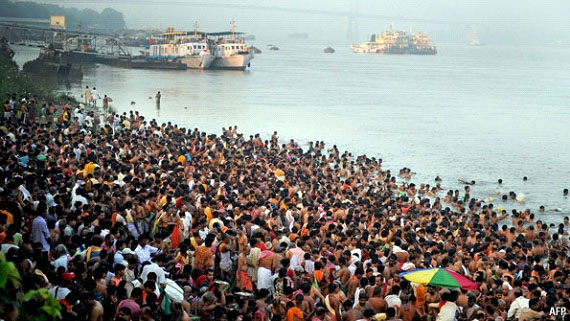世界人口到10月底將會(huì)達(dá)到70億
The world’s population will reach 7 billion at the end of October. Don’t panic

IN 1950 the whole population of the earth—2.5 billion—could have squeezed, shoulder to shoulder, onto the Isle of Wight, a 381-square-kilometre rock off southern England. By 1968 John Brunner, a British novelist, observed that the earth’s people—by then 3.5 billion—would have required the Isle of Man, 572 square kilometres in the Irish Sea, for its standing room. Brunner forecast that by 2010 the world’s population would have reached 7 billion, and would need a bigger island. Hence the title of his 1968 novel about over-population, “Stand on Zanzibar” (1,554 square kilometres off east Africa).
Brunner’s prediction was only a year out. The United Nations’ population division now says the world will reach 7 billion on October 31st 2011 (America’s Census Bureau delays the date until March 2012). The UN will even identify someone born that day as the world’s 7 billionth living person. The 6 billionth, Adnan Nevic, was born on October 12th 1999 in Sarajevo, in Bosnia. He will be just past his 12th birthday when the next billion clicks over.
That makes the world’s population look as if it is rising as fast as ever. It took 250,000 years to reach 1 billion, around 1800; over a century more to reach 2 billion (in 1927); and 32 years more to reach 3 billion. But to rise from 5 billion (in 1987) to 6 billion took only 12 years; and now, another 12 years later, it is at 7 billion (see chart 1). By 2050, the UN thinks, there will be 9.3 billion people, requiring an island the size of Tenerife or Maui to stand on.
Odd though it seems, however, the growth in the world’s population is actually slowing. The peak of population growth was in the late 1960s, when the total was rising by almost 2% a year. Now the rate is half that. The last time it was so low was in 1950, when the death rate was much higher. The result is that the next billion people, according to the UN, will take 14 years to arrive, the first time that a billion milestone has taken longer to reach than the one before. The billion after that will take 18 years.
Once upon a time, the passing of population milestones might have been cause for celebration. Now it gives rise to jeremiads. As Hillary Clinton’s science adviser, Nina Fedoroff, told the BBC in 2009, “There are probably already too many people on the planet.” But the notion of “too many” is more flexible than it seems. The earth could certainly not support 10 billion hunter-gatherers, who used much more land per head than modern farm-fed people do. But it does not have to. The earth might well not be able to support 10 billion people if they had exactly the same impact per person as 7 billion do today. But that does not necessarily spell Malthusian doom, because the impact humans have on the earth and on each other can change.
熱門推薦:
考研網(wǎng)校哪個(gè)好
新東方考研培訓(xùn)班
考研培訓(xùn)班
考研培訓(xùn)機(jī)構(gòu)哪個(gè)好
考研英語(yǔ)網(wǎng)絡(luò)課程
文都考研網(wǎng)校
北京考研培訓(xùn)班

